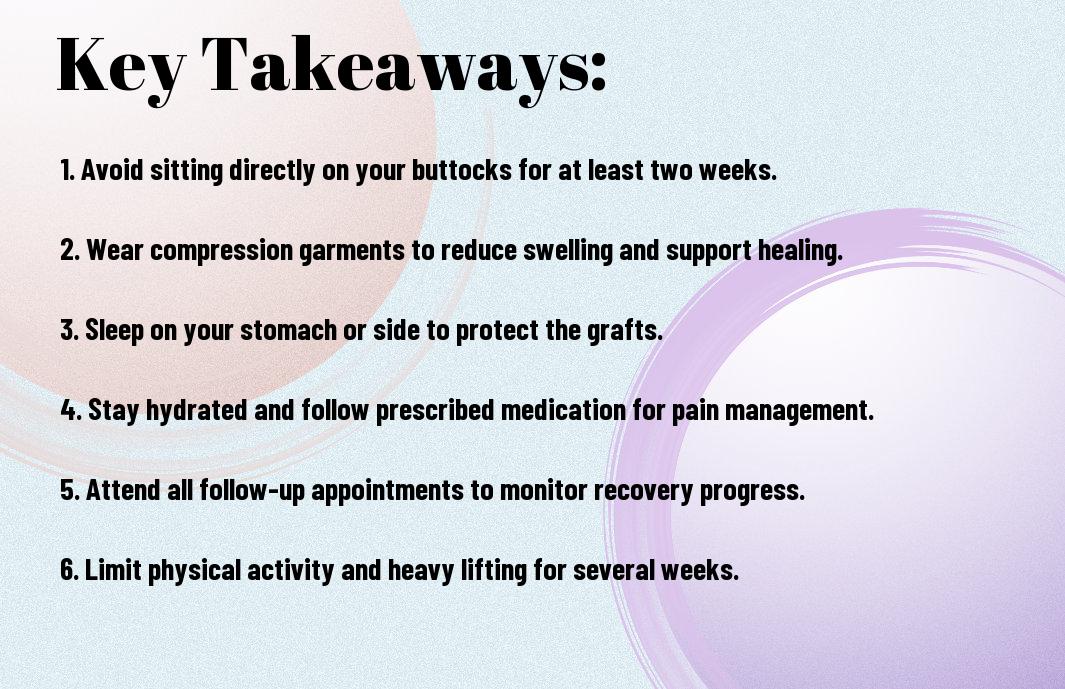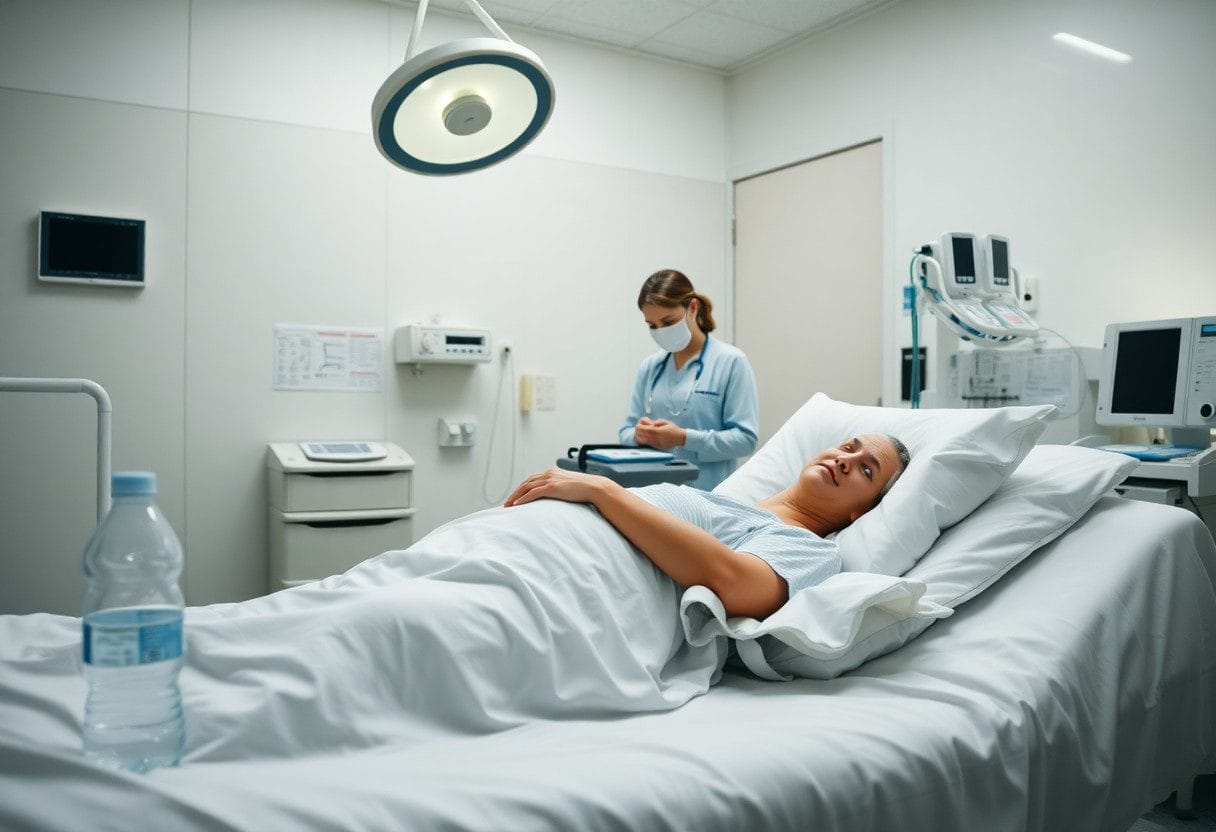You must prioritize specific post-operative care after undergoing a Brazilian butt lift to ensure a smooth recovery and optimal results. Proper care involves following your surgeon’s guidelines, managing pain, preventing complications, and maintaining the newly enhanced shape of your buttocks. In this article, we will outline imperative steps to aid your healing process, from avoiding certain activities to incorporating supportive garments that will preserve your results. Understanding these key aspects will help you navigate the recovery phase with confidence and ease.

Navigation Through the Aftermath: Initial Recovery Protocols
Following your Brazilian butt lift, your journey towards recovery begins with a series of protocols that are pivotal for successful healing. You will typically experience swelling, bruising, and some discomfort, which can take several weeks to subside. Adhering to your surgeon’s guidelines regarding activity restrictions, dietary recommendations, and follow-up appointments is vital. These steps ensure that your body heals optimally and that your new look is maintained without complications.
The Importance of Compression Garments
Wearing compression garments after your surgery is a fundamental part of your recovery. These garments help minimize swelling, support your newly contoured areas, and improve blood circulation, ultimately aiding in the healing process. Wearing your compression garment as advised by your surgeon will provide the external support your body needs during this sensitive recovery phase.
Pain Management Strategies
Managing discomfort effectively is a key aspect of your post-operative care. Your surgeon will likely prescribe medication to alleviate pain during the initial recovery period, allowing you to rest comfortably. Additionally, applying ice packs to the affected areas, elevating your body while resting, and staying hydrated can enhance your pain management experience.
Over-the-counter pain relief like acetaminophen can also complement your prescribed medications. It’s beneficial to monitor your pain levels regularly and communicate with your surgical team if pain becomes unmanageable. Keeping a journal of your pain experience allows you to have productive conversations with your medical provider, ensuring adjustments to your pain management plan can be made when necessary. An effective pain management strategy not only improves your quality of recovery but also enhances your overall emotional well-being during the healing journey.
Movement Matters: Safe Mobility Practices
Safe mobility plays a vital role in your recovery after a Brazilian butt lift. After surgery, it’s imperative to avoid putting pressure on your buttocks, which can disrupt the fat grafting process. Gentle movements, such as walking short distances around your home, promote circulation and help reduce the risk of blood clots. Stick to the advice given by your surgeon and listen to your body as you gradually increase your activity level.
The Role of Gentle Activity in Healing
Engaging in gentle activities fosters healing by enhancing blood flow to the surgical site and preventing fluid accumulation. Activities like slow walking can be beneficial, as they stimulate circulation without compromising the integrity of your fat grafts. Staying active while limiting strain allows your body to recover effectively and supports overall well-being during this crucial healing phase.
When to Gradually Reintroduce Exercise
Reintroducing exercise should happen gradually, starting around four to six weeks post-surgery. Begin with low-impact activities, such as walking and light stretching, while avoiding any exercises that strain your lower body. As your body heals, listen to how you feel and consult with your surgeon regarding the best time to transition to more challenging workouts, including strength training and cardio.
Transitioning back to exercise involves careful consideration of your body’s signals. Many practitioners recommend that you should wait at least six weeks before attempting any vigorous physical activities, but this timeline can vary based on individual healing. Regular check-ins with your surgeon will help gauge your progress and identify when you’re ready for more strenuous workouts. Customize your approach based on your unique recovery journey, and focus on building up your routine gradually to ensure optimal results.
The Diet Dilemma: Nutrition for Optimal Healing
Post-surgery recovery goes beyond just managing pain and avoiding strenuous activity; your diet plays a vital role in healing. Having the right nutrition can speed up your recovery, helping to reduce inflammation, promote tissue repair, and ensure that your body has the energy needed to heal effectively. Choosing nutrient-dense foods during this period sets the foundation for a smoother healing journey.
Essential Nutrients and Their Role
Key nutrients such as protein, vitamins A and C, and zinc are fundamental for recovery after a Brazilian butt lift. Protein supports tissue repair and muscle recovery, while vitamin A boosts immune function and skin health. Vitamin C is important for collagen production, helping your skin retain its elasticity, while zinc plays a crucial role in wound healing. Including these nutrients in your diet enhances your body’s capability to recover efficiently from the procedure.
Foods to Avoid During Recovery
Certain foods may hinder your healing process, so it’s wise to steer clear of them during recovery. High-sugar snacks, processed foods, and alcohol can increase inflammation and slow down your body’s healing response. Additionally, excessive salt can lead to swelling, and refined carbohydrates may spike your blood sugar levels, which is counterproductive for recovery.
Processed foods, loaded with preservatives and unhealthy fats, often lack the important nutrients needed for healing. Consuming these types of foods might not only prolong your recovery but could also lead to complications such as infections or fluid retention. Alcohol is a significant factor to avoid, as it can dehydrate your body and impair the immune system, making it more difficult to fend off potential infections. Prioritizing whole, nutrient-dense foods instead can effectively support your recovery journey.
Avoiding Complications: Recognizing Red Flags
Remaining vigilant during your recovery process is key to avoiding complications. Common red flags can signal issues that may need immediate attention. You should closely monitor your surgical site and overall health for unusual changes. Observing these signs early can prevent more severe complications and ensure a smoother recovery.
Signs of Infection and Other Issues
Infection signs can include increasing redness, warmth, or swelling around the incision sites, along with unusual pain that doesn’t subside with time. Additionally, fever over 100.4°F, pus drainage, or a persistent throbbing sensation can indicate dangerous complications requiring immediate evaluation. Timely recognition and intervention can make a significant difference in your recovery experience.
When to Contact Your Surgeon
Contacting your surgeon should be a priority if you notice any alarming symptoms. Your healthcare provider will appreciate being kept in the loop and can provide guidance for any changes you’ve experienced. A follow-up visit may be necessary to assess your condition, and timely communication can lead to early interventions that stabilize your recovery.
Uncertainties about your recovery shouldn’t be taken lightly. If symptoms like excessive swelling, increasing pain, or visible blood appear, reaching out to your surgeon is important. They will assess whether your body is healing properly or if there’s an underlying issue that needs to be addressed immediately. Early detection and intervention can prevent complications that might prolong your recovery or lead to more significant issues down the line.

Long-Term Care: Maintaining Your New Contours
Protecting the results of your Brazilian butt lift requires ongoing attention and care. To maintain your new contours, regular exercise that targets your glute muscles, along with a balanced diet, will help preserve skin elasticity and fat distribution. Avoiding significant weight fluctuations is vital; even small changes can alter your results. Embracing a lifestyle that promotes overall wellness will keep your newfound shape looking full and vibrant for years to come.
The Impact of Lifestyle Choices
Your lifestyle choices play a significant role in the longevity of your Brazilian butt lift results. Engaging in regular physical activity, particularly strength training that emphasizes your lower body, can help maintain and enhance your shape. Staying hydrated and making nutritious food choices will support skin health and overall body composition. Additionally, avoiding habits like smoking can help preserve your skin’s integrity and reduce the risk of complications.
Follow-Up Appointments and Ongoing Support
Regular follow-up appointments with your surgeon are necessary for monitoring your healing progress and ensuring that your body is adapting well to the new contours. These visits allow for addressing any concerns, like unevenness or unexpected changes, promptly. During these appointments, your surgeon can also provide additional guidance on maintaining your results and adapting your care plan as needed.
Follow-up appointments typically occur at set intervals post-surgery, such as one week, one month, and three months after your procedure. These consultations not only provide a platform for you to voice any concerns but also allow your surgeon to assess the healing process comprehensively. They can help you navigate any challenges you may encounter, adjusting your aftercare plan to tailor it more closely to your personal needs. Additionally, ongoing communication with your cosmetic surgery team fosters a supportive environment, ensuring that you’re not only informed but also confident in maintaining your newfound shape over time.
To wrap up
With this in mind, post-operative care after your Brazilian Butt Lift is vital for ensuring optimal results and a smooth recovery. You should focus on managing discomfort, avoiding pressure on your newly enhanced buttocks, and following your surgeon’s guidelines closely. Regular follow-ups with your healthcare provider will help monitor your progress. Prioritizing rest, maintaining a healthy diet, and staying hydrated will also support your healing process. By adhering to these imperative care steps, you can enhance your journey toward achieving the desired contour and aesthetic outcome.
FAQ
Q: What should I expect immediately after my Brazilian Butt Lift surgery in terms of post-operative care?
A: Immediately following your Brazilian Butt Lift (BBL) surgery, you will be closely monitored for any signs of complications. It’s important to have someone assist you as you may experience swelling, bruising, and discomfort, which are common after the procedure. You will likely be advised to wear a compression garment to help reduce swelling and support your body as it heals. Pain management is also an crucial part of your care, so follow your surgeon’s instructions regarding medications. Additionally, maintain a healthy hydration and nutrition regimen to support your recovery process.
Q: How long should I avoid sitting or putting pressure on my buttocks after the procedure?
A: It is recommended to avoid sitting directly on your buttocks for at least two weeks following your BBL surgery. During this period, it is advisable to use a special cushion that allows you to sit without applying pressure to the enhanced area. After the initial two weeks, gradually return to sitting while still being cautious and observing how your body responds. Each individual’s recovery timeline can vary, so keep in regular contact with your surgeon to receive personalized advice based on your healing progress.
Q: What activities should I refrain from during my recovery after a Brazilian Butt Lift?
A: Following your BBL, you should avoid any strenuous physical activities for at least six weeks. This includes heavy lifting, intense workouts, and any movements that might strain your buttock area. Light walking is encouraged to promote blood flow, but high-impact activities such as running, jumping, or specific gym exercises should be postponed until your surgeon gives you the green light. It’s also wise to refrain from activities that could cause trauma to the buttocks, such as rollercoaster rides or rough contact sports, during your initial recovery phase.